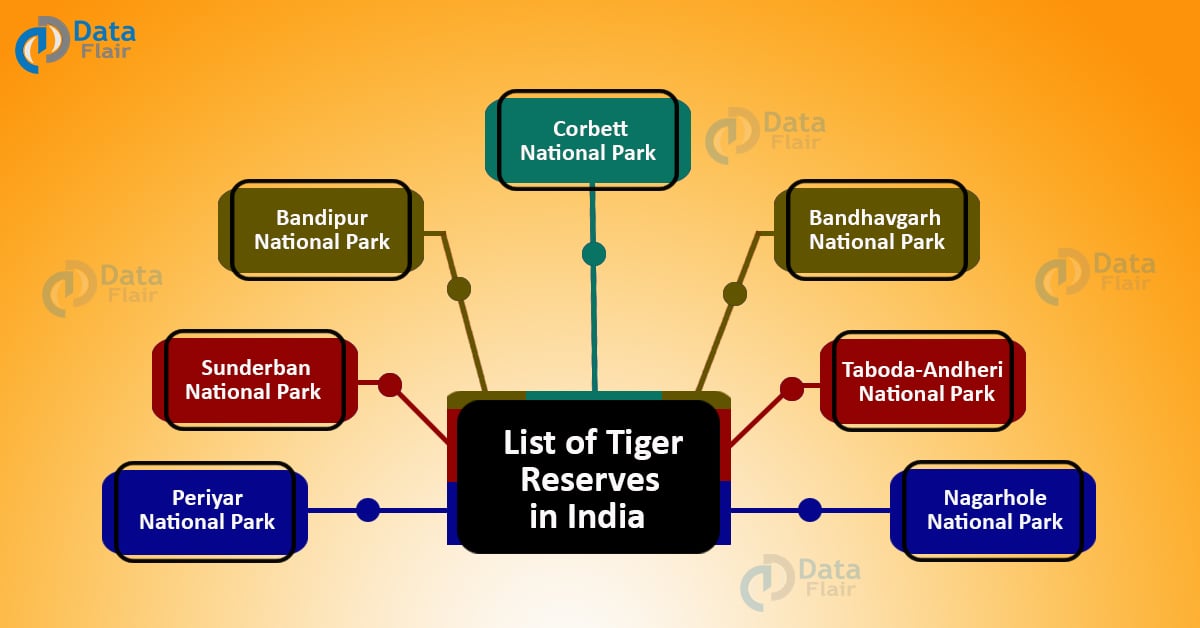List of Tiger Reserves in India – Statewise
Are you ready for UPSC Exam? Check your preparation with Free UPSC Mock Test
The National Animal of India – the Royal Bengal Tiger, has now become an endangered species. There are 50 Tiger Reserves in India, which falls under Project Tiger, maintained and administered by the National Tiger Conservation Authority (NTCA).
The NTCA was constituted under the Wild Life (Protection) Amendment Act, 2006. Tigers being only found in the Asian continent, India is the home to around 70 percent of these Tigers.
The MoU with Nepal specifies the prevention of trans-boundary illegal trade in Wildlife. Project Tiger was primarily launched in 1973 in Palamau Tiger Reserve while some sources say it was launched in 1973 in Corbett National Park.
Tiger Reserves in India
Nagarjunsagar-Srisailam Tiger Reserve (Andhra Pradesh) is the largest Tiger Reserve in India.
Bhoramdev Tiger Reserve is supposed to be the 51st Tiger Reserve in India.
Bor Tiger Reserve (Maharashtra) is the smallest Tiger Reserve in India.
The Tiger Reserves were made so as to protect the endangered species – Tigers (National Animal of India).
1. Corbett National Park – Established in 1936, Jim Corbett National Park is located in the district of Nainital, Uttarakhand and it is the First Tiger Reserve in India.
It spans over 520 sq. km and nature and wildlife can be watched in open jeeps or on elephant back. Dhikala, a place within this National Park is a bird-watching spot.
2. Bandipur National Park – Established in the year 1974 as a forest tiger reserve under the Project Tiger, Bandipur is the most prominent national park state of Karnataka and is best known for its varied wildlife.
3. Sunderban National Park – The majority part of the national park lies in Bangladesh. This park has Sundari (mangrove trees) hence it is known as Sunderbans. The Sundarbans is formed due to the confluence of the Ganga, Brahmaputra and Meghna river in the Bay of Bengal
4. Periyar National Park – It is the only park in India to have an artificial lake flowing through it. This is situated in Kerala. It stretches over an area of 305 sq. km. It is situated in the Western Ghats in South India. The Periyar River has beautiful boat rides as well.
5. Bandhavgarh National Park – Located in Madhya Pradesh, it specializes in preserving nature in the most unique way – consisting of White Tigers which are the most spectacular species found there. It is also a Tiger Reserve.
6. Manas National Park – Located in Assam, it is included in the UNESCO World Heritage Sites as well. It is under the Project Tiger and is also a biosphere reserve in Assam. It is also an elephant reserve.
Manas is famous for its wild water buffalo. It shares its national park with Bhutan as well. Orang National Park situated in Assam is also a Tiger Reserve.
7. Kanha National Park – Formed in the 19th century, this National Park in Madhya Pradesh is the only place where “Barasingha”, rather “The Jewel of India” can be found.
It is a famous Tiger Reserve. Panna National Park located in Panna and Chattarpur district of Madhya Pradesh also serves as one of the Tiger Reserve in India.
8. Pench National Park – It is located in the Seoni and Chhindwara districts of Madhya Pradesh. The name is derived from the Pench River, flowing through the National Park. It is one of the famous Tiger Reserves in India.
9. Kaziranga National Park – This national park is situated in Assam. It is very famous for its one-horned rhinoceros. It is included in the UNESCO World Heritage Site as well and is a well-known Tiger Reserve in India.
10. Taboda-Andheri National Park – It is situated in Maharashtra. This national park covers Chimur Hills, Moharli, and Kolsa Ranges. It is a Tiger Reserve as well.
11. Sariska National Park – It was previously a hunting preserve but was declared a national park in 1995. It is the world’s first national park. It is a Tiger Reserve situated in Alwar, Rajasthan.
12. Nagarhole National Park – It was previously known as the “Rajiv Gandhi National Park”. It is situated in Karnataka – in the Kodagu and Mysore districts.
13. Rajaji National Park – The park spreads over 3 districts in Uttarakhand – Haridwar, Dehradun and Pauri Garhwal in the state of Uttarakhand. It is situated at the foothills of Himalayas.
| Tiger Reserve in India | Year of establishment | State |
| Bandipur | (1973-74) | Karnataka |
| Corbett | (1973-74) | Uttarakhand |
| Amangarh (buffer of Corbett TR) | 2012 | Uttar Pradesh |
| Kanha | (1973-74) | Madhya Pradesh |
| Manas | (1973-74) | Assam |
| Melghat | (1973-74) | Maharashtra |
| Palamau | (1973-74) | Jharkhand |
| Ranthambore | (1973-74) | Rajasthan |
| Similipal | (1973-74) | Odisha |
| Sunderbans | (1973-74) | West Bengal |
| Periyar | (1978-79) | Kerala |
| Sariska | (1978-79) | Rajasthan |
| Buxa | (1982-83) | West Bengal |
| Indravati | (1982-83) | Chhattisgarh |
| Namdapha | (1982-83) | Arunachal Pradesh |
| Dudhwa | (1987-88) | Uttar Pradesh |
| Kalakad-Mundanthurai | (1988-89) | Tamil Nadu |
| Valmiki | (1989-90) | Bihar |
| Pench | (1992-93) | Madhya Pradesh |
| Tadoba-Andhari | (1993-94) | Maharashtra |
| Bandhavgarh | (1993-94) | Madhya Pradesh |
| Panna | (1994-95) | Madhya Pradesh |
| Dampa | (1994-95) | Mizoram |
| Bhadra | (1998-99) | Karnataka |
| Pench | (1998-99) | Maharashtra |
| Pakke | (1999-2000) | Arunachal Pradesh |
| Nameri | (1999-2000) | Assam |
| Satpura | (1999-2000) | Madhya Pradesh |
| Anamalai | (2008-09) | Tamil Nadu |
| Udanti-Sitanadi | (2008-09) | Chattisgarh |
| Satkosia | (2008-09) | Odisha |
| Kaziranga | (2008-09) | Assam |
| Achanakmar | (2008-09) | Chattisgarh |
| Dandeli-Anshi (Kali) | (2008-09) | Karnataka |
| Sanjay-Dubri | (2008-09) | Madhya Pradesh |
| Mudumalai | (2008-09) | Tamil Nadu |
| Nagarahole | (2008-09) | Karnataka |
| Parambikulam | (2008-09) | Kerala |
| Sahyadri | (2009-10) | Maharashtra |
| Biligiri Ranganatha Temple | (2010-11) | Karnataka |
| Kawal | (2012-13) | Telangana |
| Sathyamangalam | (2013-14) | Tamil Nadu |
| Mukandra Hills | (2013-14) | Rajasthan |
| Nawegaon-Nagzira | (2013-14) | Maharashtra |
| Nagarjunsagar Srisailam | (1982-83) | Andhra Pradesh |
| Amrabad | 2014 | Telangana |
| Pilibhit | 2014 | Uttar Pradesh |
| Bor | 2014 | Maharashtra |
| Rajaji | 2015 | Uttarakhand |
| Orang | 2016 | Assam |
| Kamlang | 2016 | Arunachal Pradesh |
Conclusion
Tigers are known to be found only in the Asian subcontinent. Hence every step is taken by the Indian government to prevent the hunting and poaching of the Royal Bengal Tigers, which is also the National Animal of India.
If you are Happy with DataFlair, do not forget to make us happy with your positive feedback on Google



We need to protect our national animal Tiger. Infact we need to create awareness among the public especially the children on the need to protect it for the future of the world. It is at the top of the food chain. So if tiger population increases it means there is ecological balance.